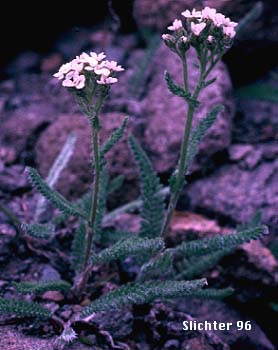 Characteristics:
Characteristics:
Yarrow is perhaps the most numerous plant in the inland Pacific Northwest. It is a native, but can sometimes be very weed-like It is an upright perennial with one main stem and occasional branching. The stems arise 3-30 cm tall. The herbage is smooth to pubescent. The basal and stem leaves are pinnately dissected, with only the lower ones petioled. The leaves alternate along the stem and are up to 15 cm long.
The inflorescence is a flat-topped corymb consisting of numerous small flower heads consisting of 3-5 white rays surrounding a tiny disk of 10-30 white flowers. The rays are 2-3 mm long.
Yarrow is found in multiple habitats, from alpine to forest, to roadside and plains.
Yarrow is found over much of the northern hemisphere. On the east coast of North America, it is most likely an import from Europe.
It is native to western North America, except along the Pacific coast. It is found from 100'-4200' intermittently throughout the gorge.
Achillein, a blood clotting extract from yarrow is used by pharmacists today to reduce clotting time. A tea may be made from the flowers, leaves, and stems to help regulate digestion and reduce lethargy. The plant is a great one for dried wintertime flora arrangements. Early in the growing season, the plant is more succulent and may thus be browsed by sheep, deer, and pronghorn. Sage grouse also may feed off of the plant.
Historically, the Nez Perce ground the dried plants into flour and used the leaves to stop bleeding. They use the leaves as a tea to reduce fevers.